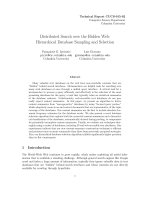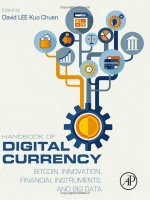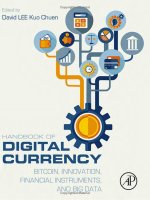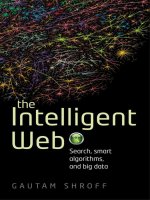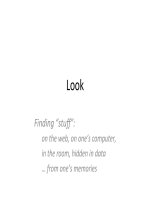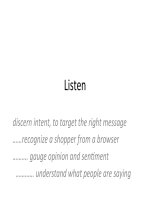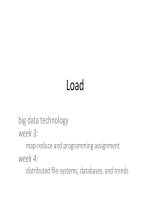The intelligent web search, smart algorithms, and big data
Bạn đang xem bản rút gọn của tài liệu. Xem và tải ngay bản đầy đủ của tài liệu tại đây (3.3 MB, 320 trang )
THE INTELLIGENT WEB
This page intentionally left blank
the
Intelligent
Web
Search, Smart Algorithms, and Big Data
GAUTAM
SHROFF
1
3
Great Clarendon Street, Oxford, OX2 6DP,
United Kingdom
Oxford University Press is a department of the University of Oxford.
It furthers the University’s objective of excellence in research, scholarship,
and education by publishing worldwide. Oxford is a registered trade mark of
Oxford University Press in the UK and in certain other countries
© Gautam Shroff 2013
The moral rights of the author have been asserted
First Edition published in 2013
Impression: 1
All rights reserved. No part of this publication may be reproduced, stored in
a retrieval system, or transmitted, in any form or by any means, without the
prior permission in writing of Oxford University Press, or as expressly permitted
by law, by licence or under terms agreed with the appropriate reprographics
rights organization. Enquiries concerning reproduction outside the scope of the
above should be sent to the Rights Department, Oxford University Press, at the
address above
You must not circulate this work in any other form
and you must impose this same condition on any acquirer
Published in the United States of America by Oxford University Press
198 Madison Avenue, New York, NY 10016, United States of America
British Library Cataloguing in Publication Data
Data available
Library of Congress Control Number: 2013938816
ISBN 978–0–19–964671–5
Printed in Italy by
L.E.G.O. S.p.A.-Lavis TN
Links to third party websites are provided by Oxford in good faith and
for information only. Oxford disclaims any responsibility for the materials
contained in any third party website referenced in this work.
To my late father,
who I suspect would have enjoyed this book the most
ACKNOWLEDGEMENTS
Many people have contributed to my thinking and encouraged me
while writing this book. But there are a few to whom I owe special thanks. First, to V. S. Subrahamanian, for reviewing the chapters
as they came along and supporting my endeavour with encouraging
words. I am also especially grateful to Patrick Winston and Pentti Kanerva for sparing the time to speak with me and share their thoughts on
the evolution and future of AI.
Equally important has been the support of my family. My wife
Brinda, daughter Selena, and son Ahan—many thanks for tolerating
my preoccupation on numerous weekends and evenings that kept me
away from you. I must also thank my mother for enthusiastically reading many of the chapters, which gave me some confidence that they
were accessible to someone not at all familiar with computing.
Last but not least I would like to thank my editor Latha Menon,
for her careful and exhaustive reviews, and for shepherding this book
through the publication process.
vi
CONTENTS
List of Figures
ix
Prologue: Potential
xi
1 Look
1
The MEMEX Reloaded
Inside a Search Engine
Google and the Mind
Deeper and Darker
2
8
20
29
2 Listen
40
Shannon and Advertising
The Penny Clicks
Statistics of Text
Turing in Reverse
Language and Statistics
Language and Meaning
Sentiment and Intent
40
48
52
58
61
66
73
3 Learn
80
Learning to Label
Limits of Labelling
Rules and Facts
Collaborative Filtering
Random Hashing
Latent Features
Learning Facts from Text
Learning vs ‘Knowing’
83
95
102
109
113
114
122
126
vii
CONTENTS
4 Connect
132
Mechanical Logic
The Semantic Web
Limits of Logic
Description and Resolution
Belief albeit Uncertain
Collective Reasoning
136
150
155
160
170
176
5 Predict
187
Statistical Forecasting
Neural Networks
Predictive Analytics
Sparse Memories
Sequence Memory
Deep Beliefs
Network Science
192
195
199
205
215
222
227
6 Correct
235
Running on Autopilot
Feedback Control
Making Plans
Flocks and Swarms
Problem Solving
Ants at Work
Darwin’s Ghost
Intelligent Systems
235
240
244
253
256
262
265
268
Epilogue: Purpose
275
References
282
Index
291
viii
LIST OF FIGURES
1 Turing’s proof
158
2 Pong games with eye-gaze tracking
187
3 Neuron: dendrites, axon, and synapses
196
4 Minutiae (fingerprint)
213
5 Face painting
222
6 Navigating a car park
246
7 Eight queens puzzle
257
ix
This page intentionally left blank
Prologue
POTENTIAL
I grew up reading and being deeply influenced by the popular science
books of George Gamow on physics and mathematics. This book is
my attempt at explaining a few important and exciting advances in
computer science and artificial intelligence (AI) in a manner accessible
to all. The incredible growth of the internet in recent years, along with
the vast volumes of ‘big data’ it holds, has also resulted in a rather
significant confluence of ideas from diverse fields of computing and
AI. This new ‘science of web intelligence’, arising from the marriage of
many AI techniques applied together on ‘big data’, is the stage on which
I hope to entertain and elucidate, in the spirit of Gamow, and to the best
of my abilities.
***
The computer science community around the world recently celebrated the centenary of the birth of the British scientist Alan Turing,
widely regarded as the father of computer science. During his rather
brief life Turing made fundamental contributions in mathematics as
well as some in biology, alongside crucial practical feats such as breaking secret German codes during the Second World War.
Turing was the first to examine very closely the meaning of what
it means to ‘compute’, and thereby lay the foundations of computer
science. Additionally, he was also the first to ask whether the capacity
of intelligent thought could, in principle, be achieved by a machine that
‘computed’. Thus, he is also regarded as the father of the field of enquiry
now known as ‘artificial intelligence’.
xi
THE INTELLIGENT WEB
In fact, Turing begins his classic 1950 article1 with, ‘I propose to consider the question, “Can machines think?” ’ He then goes on to describe
the famous ‘Turing Test’, which he referred to as the ‘imitation game’,
as a way to think about the problem of machines thinking. According
to the Turing Test, if a computer can converse with any of us humans
in so convincing a manner as to fool us into believing that it, too, is a
human, then we should consider that machine to be ‘intelligent’ and
able to ‘think’.
Recently, in February 2011, IBM’s Watson computer managed to beat
champion human players in the popular TV show Jeopardy!. Watson
was able to answer fairly complex queries such as ‘Which New Yorker
who fought at the Battle of Gettysburg was once considered the inventor of baseball?’. Figuring out that the answer is actually Abner Doubleday, and not Alexander Cartwright who actually wrote the rules of
the game, certainly requires non-trivial natural language processing
as well as probabilistic reasoning; Watson got it right, as well as many
similar fairly difficult questions.
During this widely viewed Jeopardy! contest, Watson’s place on stage
was occupied by a computer panel while the human participants were
visible in flesh and blood. However, imagine if instead the human participants were also hidden behind similar panels, and communicated
via the same mechanized voice as Watson. Would we be able to tell
them apart from the machine? Has the Turing Test then been ‘passed’,
at least in this particular case?
There are more recent examples of apparently ‘successful’ displays of artificial intelligence: in 2007 Takeo Kanade, the well-known
Japanese expert in computer vision, spoke about his early research in
face recognition, another task normally associated with humans and
at best a few higher-animals: ‘it was with pride that I tested the program
on 1000 faces, a rare case at the time when testing with 10 images
was considered a “large-scale experiment”.’2 Today, both Facebook and
Google’s Picasa regularly recognize faces from among the hundreds of
xii
POTENTIAL
millions contained amongst the billions of images uploaded by users
around the world.
Language is another arena where similar progress is visible for all to
see and experience. In 1965 a committee of the US National Academy
of Sciences concluded its review of the progress in automated translation between human natural languages with, ‘there is no immediate or
predicable prospect of useful machine translation’.2 Today, web users
around the world use Google’s translation technology on a daily basis;
even if the results are far from perfect, they are certainly good enough
to be very useful.
Progress in spoken language, i.e., the ability to recognize speech, is
also not far behind: Apple’s Siri feature on the iPhone 4S brings usable
and fairly powerful speech recognition to millions of cellphone users
worldwide.
As succinctly put by one of the stalwarts of AI, Patrick Winston: ‘AI
is becoming more important while it becomes more inconspicuous’,
as ‘AI technologies are becoming an integral part of mainstream computing’.3
***
What, if anything, has changed in the past decade that might have
contributed to such significant progress in many traditionally ‘hard’
problems of artificial intelligence, be they machine translation, face
recognition, natural language understanding, or speech recognition,
all of which have been the focus of researchers for decades?
As I would like to convince you during the remainder of this book,
many of the recent successes in each of these arenas have come
through the deployment of many known but disparate techniques
working together, and most importantly their deployment at scale,
on large volumes of ‘big data’; all of which has been made possible, and indeed driven, by the internet and the world wide web. In
other words, rather than ‘traditional’ artificial intelligence, the successes we are witnessing are better described as those of ‘web intelligence’
xiii
THE INTELLIGENT WEB
arising from ‘big data’. Let us first consider what makes big data so ‘big’,
i.e., its scale.
***
The web is believed to have well over a trillion web pages, of which
at least 50 billion have been catalogued and indexed by search engines
such as Google, making them searchable by all of us. This massive web
content spans well over 100 million domains (i.e., locations where we
point our browsers, such as <>). These are
themselves growing at a rate of more than 20,000 net domain additions daily. Facebook and Twitter each have over 900 million users,
who between them generate over 300 million posts a day (roughly 250
million tweets and over 60 million Facebook updates). Added to this
are the over 10,000 credit-card payments made per second,∗ the wellover 30 billion point-of-sale transactions per year (via dial-up POS
devices† ), and finally the over 6 billion mobile phones, of which almost
1 billion are smartphones, many of which are GPS-enabled, and which
access the internet for e-commerce, tweets, and post updates on Facebook.‡ Finally, and last but not least, there are the images and videos
on YouTube and other sites, which by themselves outstrip all these put
together in terms of the sheer volume of data they represent.
This deluge of data, along with emerging techniques and technologies used to handle it, is commonly referred to today as ‘big data’.
Such big data is both valuable and challenging, because of its sheer
volume. So much so that the volume of data being created in the current five years from 2010 to 2015 will far exceed all the data generated
in human history (which was estimated to be under 300 exabytes as
of 2007§ ). The web, where all this data is being produced and resides,
consists of millions of servers, with data storage soon to be measured
in zetabytes.¶
∗
†
‡
§
¶
<>.
< />< />< />petabyte = 1,000 GB, exabyte = 1,000 petabytes, and a zetabyte = 1,000 petabytes.
xiv
POTENTIAL
On the other hand, let us consider the volume of data an average
human being is exposed to in a lifetime. Our sense of vision provides
the most voluminous input, perhaps the equivalent of half a million
hours of video or so, assuming a fairly a long lifespan. In sharp contrast, YouTube alone witnesses 15 million hours of fresh video uploaded
every year.
Clearly, the volume of data available to the millions of machines that
power the web far exceeds that available to any human. Further, as we
shall argue later on, the millions of servers that power the web at least
match if not exceed the raw computing capacity of the 100 billion or
so neurons in a single human brain. Moreover, each of these servers
are certainly much much faster at computing than neurons, which by
comparison are really quite slow.
Lastly, the advancement of computing technology remains relentless: the well-known Moore’s Law documents the fact that computing
power per dollar appears to double every 18 months; the lesser known
but equally important Kryder’s Law states that storage capacity per
dollar is growing even faster. So, for the first time in history, we have
available to us both the computing power as well as the raw data that
matches and shall very soon far exceed that available to the average
human.
Thus, we have the potential to address Turing’s question ‘Can
machines think?’, at least from the perspective of raw computational
power and data of the same order as that available to the human brain.
How far have we come, why, and where are we headed? One of the
contributing factors might be that, only recently after many years,
does ‘artificial intelligence’ appear to be regaining a semblance of its
initial ambition and unity.
***
In the early days of artificial intelligence research following Turing’s
seminal article, the diverse capabilities that might be construed to
comprise intelligent behaviour, such as vision, language, or logical
xv
THE INTELLIGENT WEB
reasoning, were often discussed, debated, and shared at common
forums. The goals exposed by the now famous Dartmouth conference of 1956, considered to be a landmark event in the history of AI,
exemplified both a unified approach to all problems related to machine
intelligence as well as a marked overconfidence:
We propose that a 2 month, 10 man study of artificial intelligence be carried
out during the summer of 1956 at Dartmouth College in Hanover, New
Hampshire. The study is to proceed on the basis of the conjecture that every
aspect of learning or any other feature of intelligence can in principle be so
precisely described that a machine can be made to simulate it. An attempt
will be made to find how to make machines use language, form abstractions and concepts, solve kinds of problems now reserved for humans, and
improve themselves. We think that a significant advance can be made in
one or more of these problems if a carefully selected group of scientists
work on it together for a summer.4
These were clearly heady times, and such gatherings continued for
some years. Soon the realization began to dawn that the ‘problem
of AI’ had been grossly underestimated. Many sub-fields began to
develop, both in reaction to the growing number of researchers trying their hand at these difficult challenges, and because of conflicting
goals. The original aim of actually answering the question posed by
Turing was soon found to be too challenging a task to tackle all at
once, or, for that matter, attempt at all. The proponents of ‘strong AI’,
i.e., those who felt that true ‘thinking machines’ were actually possible, with their pursuit being a worthy goal, began to dwindle. Instead,
the practical applications of AI techniques, first developed as possible
answers to the strong-AI puzzle, began to lead the discourse, and it was
this ‘weak AI’ that eventually came to dominate the field.
Simultaneously, the field split into many sub-fields: image
processing, computer vision, natural language processing, speech
recognition, machine learning, data mining, computational
reasoning, planning, etc. Each became a large area of research
in its own right. And rightly so, as the practical applications of
specific techniques necessarily appeared to lie within disparate
xvi
POTENTIAL
areas: recognizing faces versus translating between two languages;
answering questions in natural language versus recognizing spoken
words; discovering knowledge from volumes of documents versus
logical reasoning; and the list goes on. Each of these were so clearly
separate application domains that it made eminent sense to study
them separately and solve such obviously different practical problems
in purpose-specific ways.
Over the years the AI research community became increasingly
fragmented. Along the way, as Pat Winston recalled, one would hear
comments such as ‘what are all these vision people doing here’3 at
a conference dedicated to say, ‘reasoning’. No one would say, ‘well,
because we think with our eyes’,3 i.e., our perceptual systems are intimately involved in thought. And so fewer and fewer opportunities
came along to discuss and debate the ‘big picture’.
***
Then the web began to change everything. Suddenly, the practical
problem faced by the web companies became larger and more holistic: initially there were the search engines such as Google, and later
came the social-networking platforms such as Facebook. The problem, however, remained the same: how to make more money from
advertising?
The answer turned out to be surprisingly similar to the Turing Test:
Instead of merely fooling us into believing it was human, the ‘machine’,
i.e., the millions of servers powering the web, needed to learn about
each of us, individually, just as we all learn about each other in casual
conversation. Why? Just so that better, i.e., more closely targeted,
advertisements could be shown to us, thereby leading to better ‘bang
for the buck’ of every advertising dollar. This then became the holy
grail: not intelligence per se, just doing better and better at this ‘reverse’
Turing Test, where instead of us being observer and ‘judge’, it is the
machines in the web that observe and seek to ‘understand’ us better for
their own selfish needs, if only to ‘judge’ whether or not we are likely
xvii
THE INTELLIGENT WEB
buyers of some of the goods they are paid to advertise. As we shall see
soon, even these more pedestrian goals required weak-AI techniques
that could mimic many of capabilities required for intelligent thought.
Of course, it is also important to realize that none of these efforts
made any strong-AI claims. The manner in which seemingly intelligent
capabilities are computationally realized in the web does not, for the
most part, even attempt to mirror the mechanisms nature has evolved
to bring intelligence to life in real brains. Even so, the results are quite
surprising indeed, as we shall see throughout the remainder of this
book.
At the same time, this new holy grail could not be grasped with
disparate weak-AI techniques operating in isolation: our queries as we
searched the web or conversed with our friends were words; our actions
as we surfed and navigated the web were clicks. Naturally we wanted to
speak to our phones rather than type, and the videos that we uploaded
and shared so freely were, well, videos.
Harnessing the vast trails of data that we leave behind during our
web existences was essential, which required expertise from different
fields of AI, be they language processing, learning, reasoning, or vision,
to come together and connect the dots so as to even come close to
understanding us.
First and foremost the web gave us a different way to look for information, i.e., web search. At the same time, the web itself would listen
in, and learn, not only about us, but also from our collective knowledge
that we have so well digitized and made available to all. As our actions
are observed, the web-intelligence programs charged with pinpointing
advertisements for us would need to connect all the dots and predict
exactly which ones we should be most interested in.
Strangely, but perhaps not surprisingly, the very synthesis of techniques that the web-intelligence programs needed in order to connect
the dots in their practical enterprise of online advertising appears, in
many respects, similar to how we ourselves integrate our different
xviii
POTENTIAL
perceptual and cognitive abilities. We consciously look around us to
gather information about our environment as well as listen to the ambient sea of information continuously bombarding us all. Miraculously,
we learn from our experiences, and reason in order to connect the dots
and make sense of the world. All this so as to predict what is most likely
to happen next, be it in the next instant, or eventually in the course
of our lives. Finally, we correct our actions so as to better achieve our
goals.
***
I hope to show how the cumulative use of artificial intelligence techniques at web scale, on hundreds of thousands or even millions of
computers, can result in behaviour that exhibits a very basic feature
of human intelligence, i.e., to colloquially speaking ‘put two and two
together’ or ‘connect the dots’. It is this ability that allows us to make
sense of the world around us, make intelligent guesses about what is
most likely to happen in the future, and plan our own actions accordingly.
Applying web-scale computing power on the vast volume of ‘big
data’ now available because of the internet, offers the potential to create far more intelligent systems than ever before: this defines the new
science of web intelligence, and forms the subject of this book.
At the same time, this remains primarily a book about weak AI:
however powerful this web-based synthesis of multiple AI techniques
might appear to be, we do not tread too deeply in the philosophical
waters of strong-AI, i.e., whether or not machines can ever be ‘truly
intelligent’, whether consciousness, thought, self, or even ‘soul’ have
reductionist roots, or not. We shall neither speculate much on these
matters nor attempt to describe the diverse philosophical debates and
arguments on this subject. For those interested in a comprehensive
history of the confluence of philosophy, psychology, neurology, and
artificial intelligence often referred to as ‘cognitive science’, Margaret
xix
THE INTELLIGENT WEB
Boden’s recent volume Mind as Machine: A History of Cognitive Science5 is
an excellent reference.
Equally important are Turing’s own views as elaborately explained
in his seminal paper1 describing the ‘Turing test’. Even as he clearly
makes his own philosophical position clear, he prefaces his own beliefs
and arguments for them by first clarifying that ‘the original question, “Can machines think?” I believe to be too meaningless to deserve
discussion’.1 He then rephrases his ‘imitation game’, i.e., the Turing
Test that we are all familiar with, by a statistical variant: ‘in about fifty
years’ time it will be possible to program computers . . . so well that
an average interrogator will not have more than 70 per cent chance
of making the right identification after five minutes of questioning’.1
Most modern-day machine-learning researchers might find this formulation quite familiar indeed. Turing goes on to speculate that ‘at
the end of the century the use of words and general educated opinion
will have altered so much that one will be able to speak of machines
thinking without expecting to be contradicted’.1 It is the premise of this
book that such a time has perhaps arrived.
As to the ‘machines’ for whom it might be colloquially acceptable to
use the word ‘thinking’, we look to the web-based engines developed
for entirely commercial pecuniary purposes, be they search, advertising, or social networking. We explore how the computer programs
underlying these engines sift through and make sense of the vast volumes of ‘big data’ that we continuously produce during our online
lives—our collective ‘data exhaust’, so to speak.
In this book we shall quite often use Google as an example and
examine its innards in greater detail than others. However, when we
speak of Google we are also using it as a metaphor: other search
engines, such as Yahoo! and Bing, or even the social networking world
of Facebook and Twitter, all share many of the same processes and
purposes.
xx
POTENTIAL
The purpose of all these web-intelligence programs is simple: ‘all
the better to understand us’, paraphrasing Red Riding Hood’s wolf in
grandmother’s clothing. Nevertheless, as we delve deeper into what
these vast syntheses of weak-AI techniques manage to achieve in practice, we do find ourselves wondering whether these web-intelligence
systems might end up serving us a dinner far closer to strong AI than
we have ever imagined for decades.
That hope is, at least, one of the reasons for this book.
***
In the chapters that follow we dissect the ability to connect the dots,
be it in the context of web-intelligence programs trying to understand
us, or our own ability to understand and make sense of the world. In
doing so we shall find some surprising parallels, even though the two
contexts and purposes are so very different. It is these connections that
offer the potential for increasingly capable web-intelligence systems in
the future, as well as possibly deeper understanding and appreciation
of our own remarkable abilities.
Connecting the dots requires us to look at and experience the world
around us; similarly, a web-intelligence program looks at the data
stored in or streaming across the internet. In each case information
needs to be stored, as well as retrieved, be it in the form of memories
and their recollection in the former, or our daily experience of web
search in the latter.
Next comes the ability to listen, to focus on the important and discard the irrelevant. To recognize the familiar, discern between alternatives or identify similar things. Listening is also about ‘sensing’ a
momentary experience, be it a personal feeling, individual decision,
or the collective sentiment expressed by the online masses. Listening
is followed eventually by deeper understanding: the ability to learn
about the structure of the world, in terms of facts, rules, and relationships. Just as we learn common-sense knowledge about the world
around us, web-intelligence systems learn about our preferences and
xxi
THE INTELLIGENT WEB
behaviour. In each case the essential underlying processes appear quite
similar: detecting the regularities and patterns that emerge from large
volumes of data, whether derived from our personal experiences while
growing up, or via the vast data trails left by our collective online
activities.
Having learned something about the structure of the world, real or
its online rendition, we are able to connect different facts and derive
new conclusions giving rise to reasoning, logic, and the ability to deal
with uncertainty. Reasoning is what we normally regard as unique
to our species, distinguishing us from animals. Similar reasoning by
machines, achieved through smart engineering as well as by crunching
vast volumes of data, gives rise to surprising engineering successes
such as Watson’s victory at Jeopardy!.
Putting everything together leads to the ability to make predictions
about the future, albeit tempered with different degrees of belief. Just
as we predict and speculate on the course of our lives, both immediate
and long-term, machines are able to predict as well—be it the supply and demand for products, or the possibility of crime in particular
neighbourhoods. Of course, predictions are then put to good use for
correcting and controlling our own actions, for supporting our own
decisions in marketing or law enforcement, as well as controlling complex, autonomous web-intelligence systems such as self-driving cars.
In the process of describing each of the elements: looking, listening,
learning, connecting, predicting, and correcting, I hope to lead you through
the computer science of semantic search, natural language understanding, text mining, machine learning, reasoning and the semantic
web, AI planning, and even swarm computing, among others. In each
case we shall go through the principles involved virtually from scratch,
and in the process cover rather vast tracts of computer science even if
at a very basic level.
Along the way, we shall also take a closer look at many examples of
web intelligence at work: AI-driven online advertising for sure, as well
xxii
POTENTIAL
as many other applications such as tracking terrorists, detecting disease outbreaks, and self-driving cars. The promise of self-driving cars,
as illustrated in Chapter 6, points to a future where the web will not
only provide us with information and serve as a communication platform, but where the computers that power the web could also help us
control our world through complex web-intelligence systems; another
example of which promises to be the energy-efficient ‘smart grid’.
***
By the end of our journey we shall begin to suspect that what began
with the simple goal of optimizing advertising might soon evolve to
serve other purposes, such as safe driving or clean energy. Therefore
the book concludes with a note on purpose, speculating on the nature
and evolution of large-scale web-intelligence systems in the future. By
asking where goals come from, we are led to a conclusion that surprisingly runs contrary to the strong-AI thesis: instead of ever mimicking human intelligence, I shall argue that web-intelligence systems are
more likely to evolve synergistically with our own evolving collective
social intelligence, driven in turn by our use of the web itself.
In summary, this book is at one level an elucidation of artificial
intelligence and related areas of computing, targeted for the lay but
patient and diligent reader. At the same time, there remains a constant
and not so hidden agenda: we shall mostly concern ourselves with
exploring how today’s web-intelligence applications are able to mimic
some aspects of intelligent behaviour. Additionally however, we shall
also compare and contrast these immense engineering feats to the
wondrous complexities that the human brain is able to grasp with such
surprising ease, enabling each of us to so effortlessly ‘connect the dots’
and make sense of the world every single day.
xxiii
This page intentionally left blank
